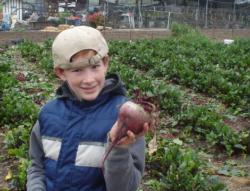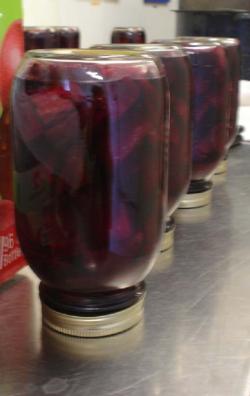4-H Delivers
4-H Horticulture Group Helps Museum and Meals On Wheels
The Issue
Today's youth are more removed from the source of food. Most adults are unaware of all that goes into making a canned food item. Everyone who has a home garden grows at least eight different things, each of which needs to be processed or preserved differently. Hunger, use of resources, and food production; are all complicated issues. In the effort to simplify, learn, and explore, what is a good approach? If you had to pick one thing to grow, what would be the ideal vegetable?
Beets are ideal. They take 60 days to be ready to harvest. Several plants come up with seed so thinning is required. The thinned plants are edible or can be composted. The harvest is fun and after separating the greens from the beet root, both parts are usable. The greens can be cooked briefly, bagged, and frozen. The beets can be pickled and any extras can be frozen after cooking. The waste from harvest and pickling can be composted. They have more manganese and potassium (vital nutrients) than a banana.

What has 4-H done?
The Buena Vista 4-H club is only one year old and has been meeting at a local museum. The museum has a year-round garden. Part of the year they grow beets to pickle and sell for fund raising. They gave the club's Horticulture group a section of the garden to use, as well as seed and water. The project group was guided in making furrows, setting "soaker" hoses, and how to plant seeds on each side of the buried "soaker" hose.
The principles of SET were applied to observe, explore, and discuss different types of soil samples, to observe what size plants grow in different textures of soils, and to compare the nutrients in beets compared to bananas.
The project toured the Horticulture Department at a local college. There were 3 canning parties, two of which were to process the museum's beets. The project group became proficient at pickling beets as they worked with the museum's volunteers. They helped the museum to have a very successful season of pickling beets, 37 quart size cases total. The group helped sell the museum's pickled beets and were able to share with the public what 4-H is doing and their role in producing canned foods. They met with Meals On Wheels to make a donation of 4-H pickled beets.
The club learned what Meals on Wheels is and how they do what they do. Meals On Wheels help many elderly who cannot cook or shop for themselves. The recipients of the 4-H pickled beets will hear about 4-H and where the beets came from. For many, those pickled beets will be a real treat.

The Payoff
The project group learned the skills of weed control, wise water use, harvesting, pickling beets, preserving beet greens, the many uses of beets in food, and their nutrition.
They excelled in generosity in their many hours of community service while working with the museum's volunteers and giving pickled beets to Meals On Wheels.
The project group looks forward to returning to the college to see their continued changes and progress in the Horticulture Department. They look forward to helping Meals on Wheels and are now helping the museum plant sorghum. Seed to jar, it's another new adventure and none of this would have started without the Service Learning RFP; they were the first seed for this project.
Authored by: Melissa Woodall, Buena Vista 4-H Horticulture Project



